Disclosure: This post may contain affiliate links. I may earn a small commission for my endorsement, recommendation, testimonial, and/or link to any products or services from this website.
These old-fashioned fig preserves require just 3 ingredients — and no pectin! One of the easiest jams to make, there’s very little prep work necessary. Just simmer a pot on the stove for a couple of hours and you’ll have a few jars of beautiful, preserved fresh figs to enjoy with cheese on your next charcuterie board, to spread on biscuits, cornbread, or toast, to elevate sandwiches, or to use in baked goods like cakes.
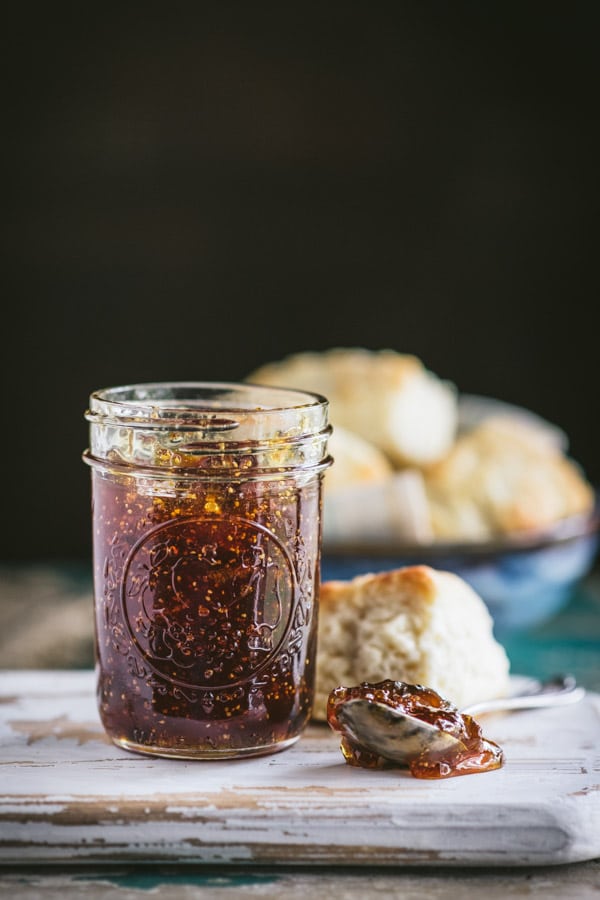
Table of Contents
Figs generally ripen twice a year: the first or “breba” season is typically in early June, while the second or “new wood” season generally runs from August through October. When my neighbor’s Brown Turkey figs ripened early this year (thanks to a warm winter in Virginia), she was happy to share some with us. There’s no better way to enjoy a bunch of figs than turning them into fig preserves!
Old Fashioned Fig Preserves
This is a standard, old-fashioned fig preserves recipe, which includes equal amounts of both figs and sugar. It’s easy to scale up or down, depending on how many figs you have, or how many jars you plan to make. The thinly-sliced lemon is another classic ingredient, which adds acidic brightness to balance out the sweetness of the figs.
I’ve included instructions for canning fig preserves below, but you can also skip the step of processing the jars in a hot water bath and just store the preserves in the refrigerator if you prefer.
Fig Preserves vs. Fig Jam
Fig preserves are not technically the same as fig jam, although this particular recipe yields a jar of preserves that’s quite similar to jam. In general, jam is made with mashed fruit while preserves have whole fruit or large pieces of fruit throughout.
This whole fig preserves recipe starts with the whole fruit (just the stems removed). You don’t need to chop, peel, mash, or process the figs before adding them to the pot.
As the figs cook, soften, and break down, I like to use my wooden spoon to break apart some of the larger pieces of fruit. In the end, you have a chunky fig spread that actually resembles jam more than preserves. If you prefer whole fig preserves with large chunks or the fruit intact, that’s fine…just don’t break them apart as much when you’re stirring the pot.
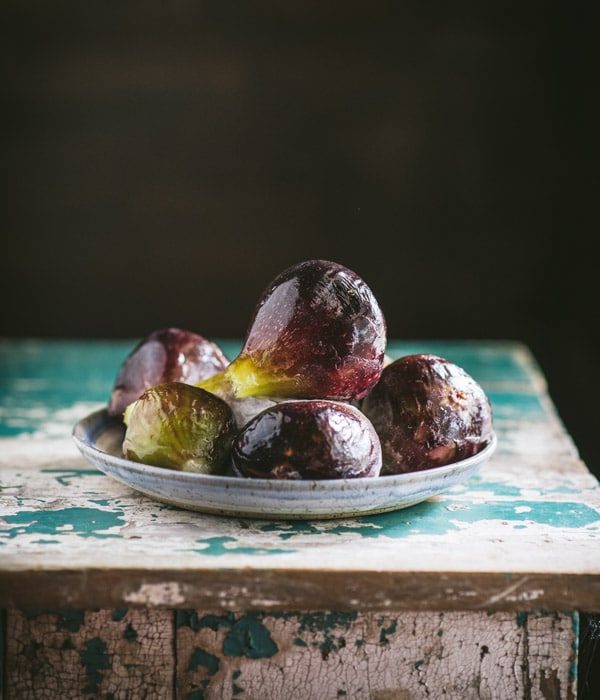
Ingredients
This is an overview of the ingredients that you’ll need for an old fashioned fig preserves recipe without pectin. As always, specific measurements and complete cooking instructions are included in the printable recipe box at the bottom of the post.
- Fresh figs: I use Brown Turkey figs, but you can use Black Mission figs or just about any other fresh figs available.
- Granulated sugar: this classic Southern recipe calls for an equal amount of sugar and figs; however, you can see my note below to adjust the recipe for less sugar.
- Lemon: gives the spread a bright, acidic note that balances the sweetness of the figs and helps to make the preserves safe for shelf-stable canning.
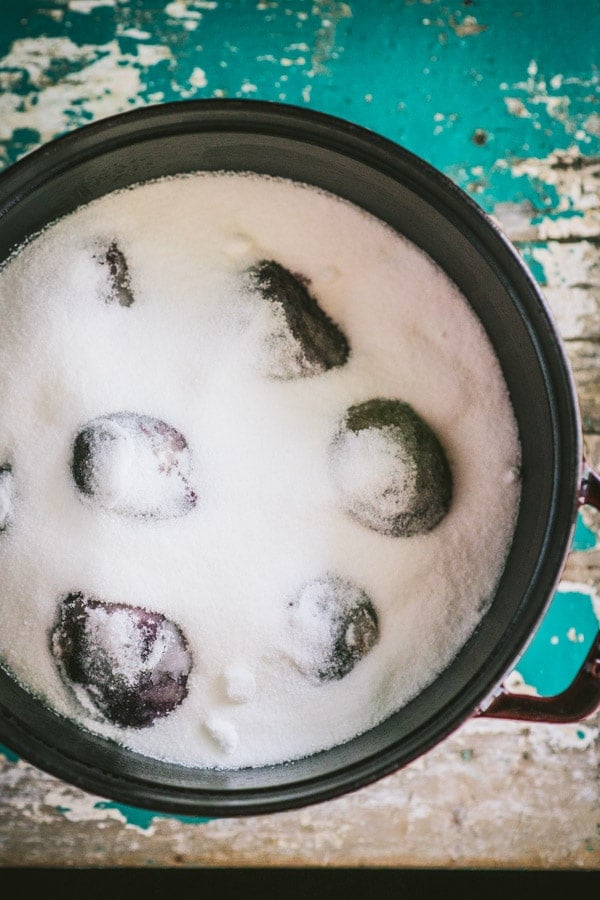
Equipment Needed
- 3 sterilized half-pint mason jars and lids: this recipe yields enough for about 3 (8-ounce) jars of jam. I like the half-pint jars because it’s just the right amount of jam to keep in the fridge after it’s opened, but smaller 4-ounce jars are also a great option.
- A sterilized funnel: this makes it easier to get the jam inside the jar without spilling; however, it’s fine if you don’t have a funnel — you can carefully spoon the jam into the jars instead.
- Tongs: canning tongs are incredibly helpful when taking the jars in and out of the boiling water.
- Stock pot, saucepan, or Dutch oven: for cooking the preserves.
- Canner or large pot for boiling jars: this needs to be very deep so that you can cover the jars with at least 1-2 inches of water. I use my deepest stock pot for this step, since I don’t have an official canner to process the jars.
- Wooden spoon: to stir, stir, stir so that the jam doesn’t stick to the pot!
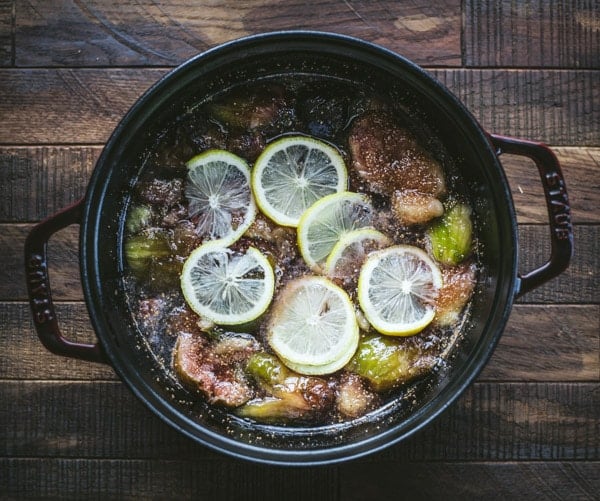
How to Sterilize Jars and Lids for Jam or Preserves
It’s a good practice to sterilize the jars and lids before canning in order to kill any bacteria, fungi or yeast. There are a variety of ways to sterilize the jars (here’s a helpful article with different options). I typically use the dishwasher, or just boil them for 10 minutes in the same big pot of water that I’ll use for processing.
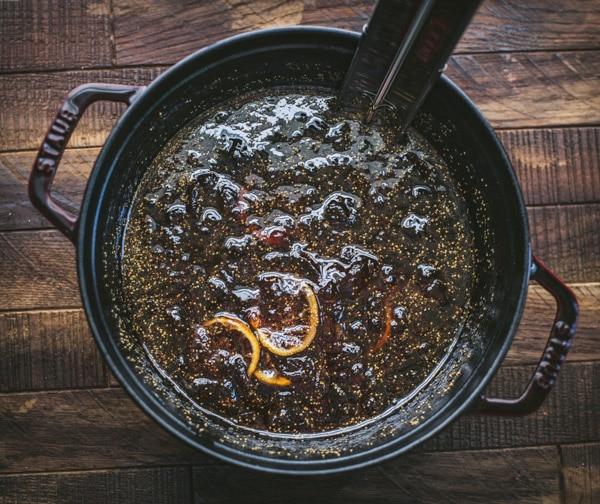
How to Make Fig Preserves
This recipe is incredibly simple — no peeling, mashing, or chopping necessary! Just remember to plan ahead and let the figs sit in the sugar overnight. The fruit will release juices as it sits, and you won’t need to add any water to the pot in the morning.
I’ve included the detailed directions in the recipe card below, but here’s the quick overview:
- Cut off the stems from the figs.
- Place figs in a large pot or Dutch oven and cover with sugar.
- Cover the pot and let the figs sit in the sugar overnight.
- Heat the pot on the stovetop over medium heat. Cook, stirring constantly, until the sugar dissolves (this only takes a few minutes).
- Reduce the heat to low, add the lemon slices, and cook for about 2 hours.
- Divide the figs and syrup between sterilized jars. Wipe rims clean with paper towels, then secure lids and rings.
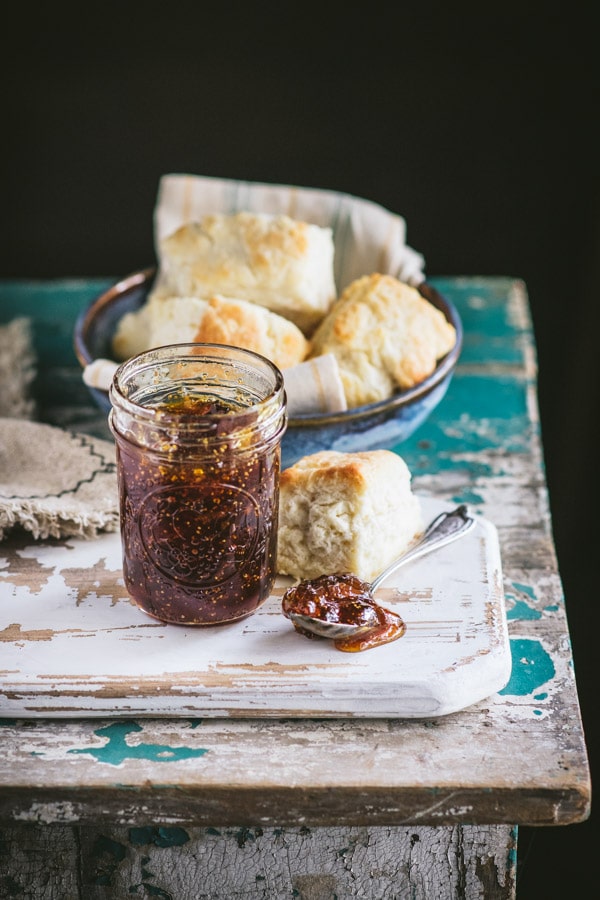
How to Thicken Fig Preserves
You don’t need added pectin to thicken this fig preserve recipe. Instead, the slow cooking process allows the figs and sugar to naturally thicken on their own.
The longer you simmer the pot, the thicker the jam will be. This typically takes about 2 hours, but it might be a bit less or a bit more. As a result, I find that it’s most helpful to use a candy or deep-fry thermometer to know exactly when the mixture reaches the jelling point of 220-225°F.
It’s important that you don’t cook the preserves for too long, or the mixture will be too thick to spread once it cools.
Canning Fig Preserves
Once the sterilized jars are full and sealed, set the hot jars on a rack in a canner or in a large pot of boiling water. Make sure that the pot is deep enough so that the jars are covered by at least 1-2 inches of boiling water. Boil for 10 minutes (or 15 minutes if your altitude is above 6,000 feet).
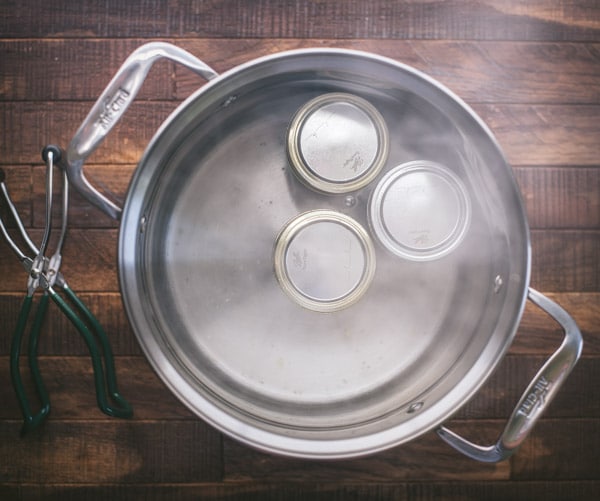
How long does it take for easy fig preserves to set?
Once the jars are filled and processed in the hot water bath for 10 minutes, place the jars on a dish towel on the counter. The jam will not set immediately, so it’s important to allow the jars to rest without interruption at room temperature until cool (or overnight), about 12 hours. Don’t forget that the preserves will continue to thicken as they cool and set.
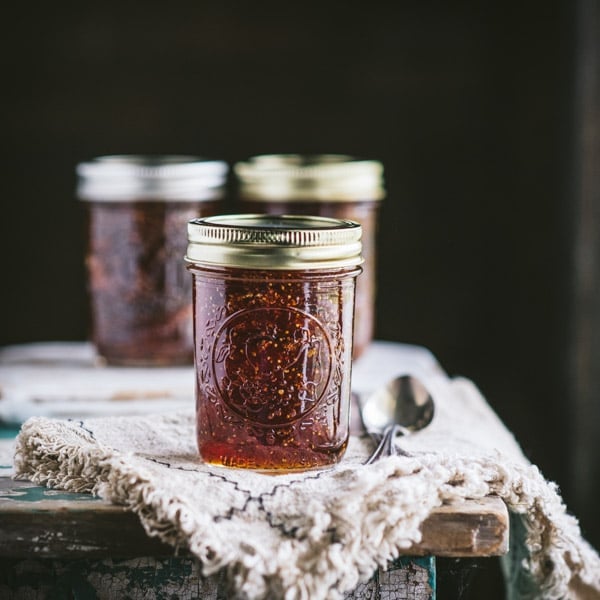
Storage
Once the jam has had a chance to cool, you can check the seals on your jars. The lids should be down in the center or stay down when pressed. Unsealed jars should be refrigerated and used within 3 weeks. Properly sealed and processed jars of fig preserves should be stored in a cool, dark, dry place (such as a pantry) for up to 8 months.
If you choose not to process your jars of preserves in a hot water bath, they need to be stored in the refrigerator. These jars will stay fresh for up to 3 weeks. To freeze unprocessed jars of preserves, be sure to leave about 1-inch of headspace at the top of each jar to allow for expansion.
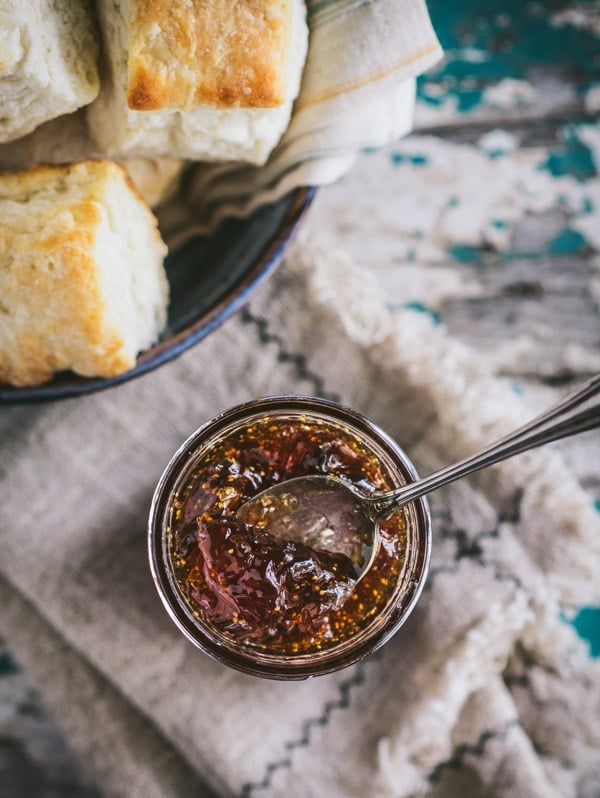
What do you eat fig preserves with?
This versatile fig spread is delicious in a variety of dishes. Try serving the preserves:
- Spread on biscuits, cornbread, or toast.
- On a cheese plate at your next cocktail hour.
- On top of brie cheese.
- Stirred into oatmeal for breakfast.
- Over vanilla ice cream for dessert.
- On sandwiches for a sweet contrast to smoked turkey, country ham, roast beef or Swiss cheese.
- In baked goods such as cakes and bars.
Fig Preserves Recipe Variations
- Less sugar. While many old time fig preserves recipes call for equal parts figs and sugar, some folks prefer a less-sweet jar of preserves. Feel free to play around with the ratio and reduce the amount of sugar in your pot to suit your taste preferences — especially if the figs that you’re using are already very sweet on their own.
- Fig preserves without lemon. The lemon adds a nice acidic balance to the sweet figs, and gives the spread a marmalade-like taste. It’s also an important ingredient if you want your preserves to be shelf-stable. If you’re just planning to refrigerate your preserves for up to 1 month (and skip the hot water bath), then you can omit the lemons if you like.
- This recipe yields a small batch of just 3 jars; however, you can scale the recipe to make a larger batch. If you have a bunch of figs available, just multiply all of the ingredients to create more preserves. For instance, use 3 lbs. of figs, 3 lbs. of sugar and 1 whole lemon.
- If you don’t want to bother with canning the jars in a water bath, no problem! Just transfer the jam to jars, let them cool completely at room temperature, and then store in the refrigerator for up to 3 weeks.
- I used Brown Turkey figs here, but you can substitute with Black Mission figs or just about any other fresh figs available.
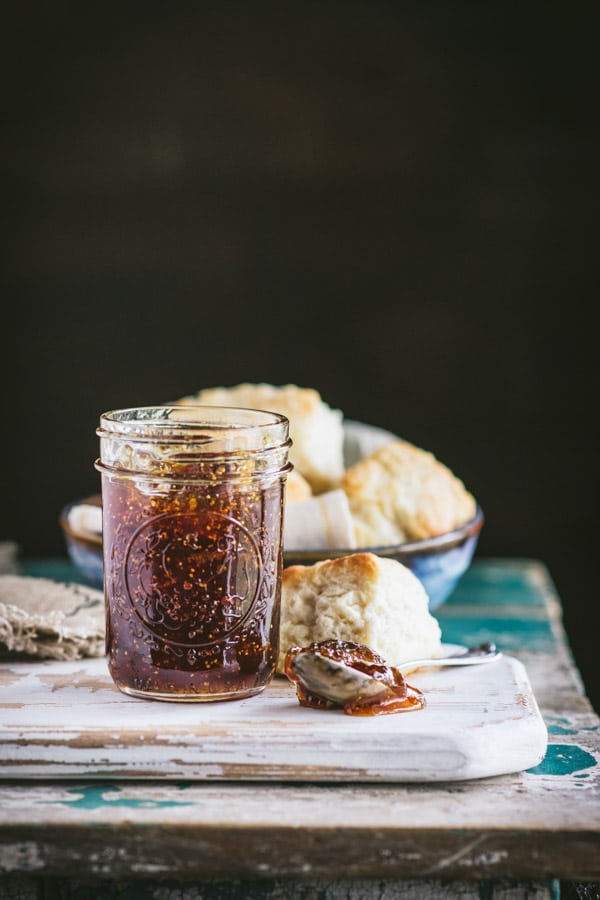
Tips for the Best Fig Preserves Recipe
- Do not overcook the preserves or the mixture will become too thick to spread. The preserves thicken significantly as they cool and set, so don’t worry if the syrup still looks fairly thin at the end. The total cooking time may vary — in some instances you might need less than 2 hours, in some instances more. This is why I find a candy thermometer to be so helpful — you’ll know exactly when it reaches the jelling point of 220-225° F.
- If possible, weigh your fruit after trimming the stems. This will give you a more accurate measurement to make sure that you have the correct amount of fruit. For instance, I started with about 1 ¾ lbs. of fresh figs before trimming, which left me with 1 ½ lbs. of fruit to use in the recipe.
- Slice the lemon paper-thin before adding it to the pot. This way you’ll end up with bits of lemon throughout, but you won’t have any big chunks to bite into.
- Use a wooden spoon to break up the large figs as they cook if you prefer a jam-like consistency. For whole fig preserves, leave the figs intact (they will still be soft and spreadable).
- Leave ¼-inch of headspace in each jar. The proper amount of headspace is important to ensure a vacuum seal. If there’s too little headspace, the preserves may expand and bubble out when air is being forced out from under the lid during processing.
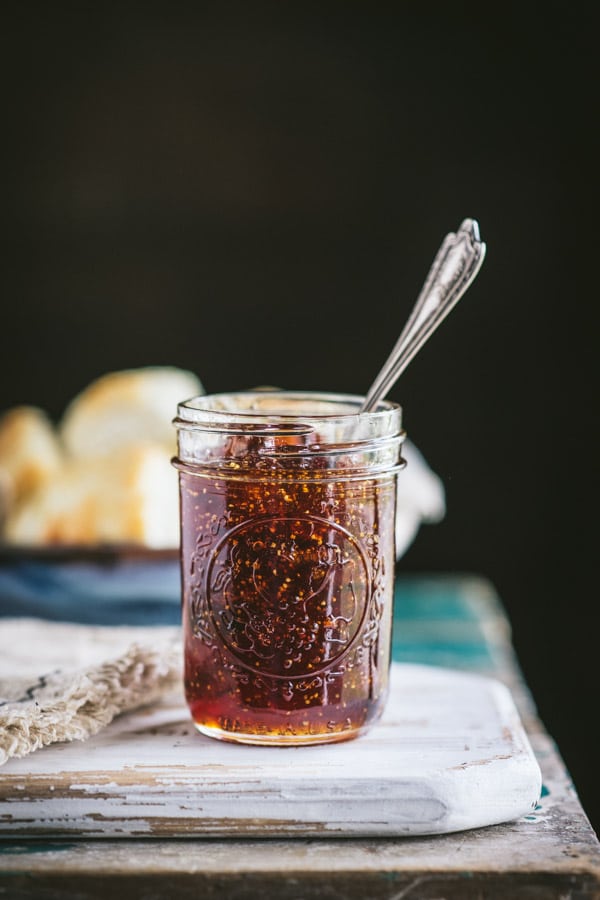
More Homemade Jam Recipes to Try
Blackberry Jam {With or Without Pectin}
12 hours hrs 55 minutes mins
Spiced Apple Pear Jam
45 minutes mins
Blueberry Jam
12 hours hrs 40 minutes mins
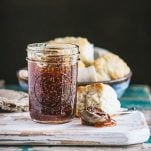
Fig Preserves Recipe without Pectin
Equipment
Ingredients
- 1 ½ lbs. fresh figs, stems removed
- 1 ½ lbs. granulated sugar (approximately 3 ¼ cups)
- ½ of a lemon, sliced paper-thin and seeds removed
Instructions
- Place the figs in a large pot. Pour the sugar over the figs, cover the pot, and let sit overnight.
- Heat the pot on the stovetop over medium heat. Cook, stirring constantly, until the sugar dissolves (this only takes a few minutes). Reduce the heat to low, add the lemon slices, and cook for about 2 hours (or until the syrup is thick). If the figs are particularly large, I like to use a wooden spoon or a potato masher to gently break apart the big chunks as the figs soften. If you have a deep fry or candy thermometer, you’re looking for a jelling point of 220-225°F.
- Divide the figs and syrup between 3 sterilized 8-ounce glass jars, leaving ¼-inch of headspace at the top of each jar. Wipe the rims clean with a damp cloth, then secure the lids and bands.
- Process in a boiling water bath for 10 minutes (or 15 minutes if your altitude is above 6,000 feet). Carefully remove the jars to a towel on the counter. Let stand, undisturbed, for 12 hours at room temperature. Check the seals after 12 hours by pressing the center of the lids. If the lid gives or the center button remains popped up, store in the refrigerator for up to 1 month. Properly sealed jars will keep in a cool, dark place for up to 8 months. Refrigerate after opening.
Notes
- Less sugar. While many old time fig preserves recipes call for equal parts figs and sugar, some folks prefer a less-sweet jar of preserves. Feel free to play around with the ratio and reduce the amount of sugar in your pot to suit your taste preferences — especially if the figs that you’re using are already very sweet on their own.
- Fig preserves without lemon. The lemon adds a nice acidic balance to the sweet figs, and gives the spread a marmalade-like taste. It’s also an important ingredient if you want your preserves to be shelf-stable. If you’re just planning to refrigerate your preserves for up to 1 month (and skip the hot water bath), then you can omit the lemons if you like.
- Scale the recipe to make a larger batch. If you have a bunch of figs available, just multiply all of the ingredients to create more preserves. For instance, use 3 lbs. of figs, 3 lbs. of sugar and 1 whole lemon.
- If you don’t want to bother with canning the jars in a water bath, no problem! Just transfer the jam to jars, let them cool completely at room temperature, and then store in the refrigerator for up to 3 weeks.
- I used Brown Turkey figs here, but you can substitute with Black Mission figs or just about any other fresh figs available.
- Do not overcook the preserves or the mixture will become too thick to spread. The preserves thicken up significantly as they cool and set, so don’t worry if the syrup still looks fairly thin at the end. The total cooking time may vary — in some instances you might need less than 2 hours, in some instances more. This is why I find a candy thermometer to be so helpful — you’ll know exactly when it reaches the jelling point of 220-225° F.
- If possible, weigh your fruit after trimming the stems. This will give you a more accurate measurement to make sure that you have the correct amount of fruit. For instance, I started with about 1 ¾ lbs. of fresh figs before trimming, which left me with 1 ½ lbs. of fruit to use in the recipe.
- Slice the lemon paper-thin before adding it to the pot. This way you’ll end up with bits of lemon throughout, but you won’t have any big chunks to bite into.
- Use a wooden spoon to break up the large figs as they cook if you prefer a jam-like consistency. For whole fig preserves, leave the figs intact (they will still be soft and spreadable).
- Leave ¼-inch of headspace in each jar. The proper amount of headspace is important to ensure a vacuum seal. If there’s too little headspace, the preserves may expand and bubble out when air is being forced out from under the lid during processing.
- Recipe adapted from Jan Karon’s Mitford Cookbook & Kitchen Reader.
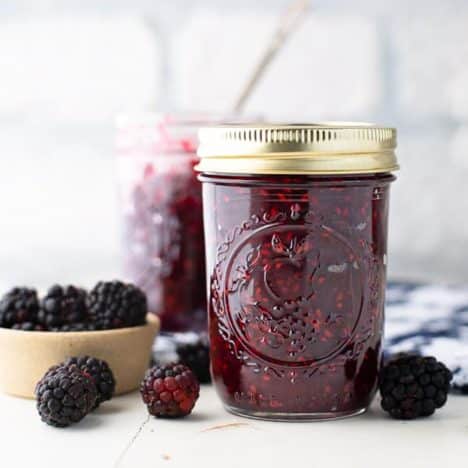
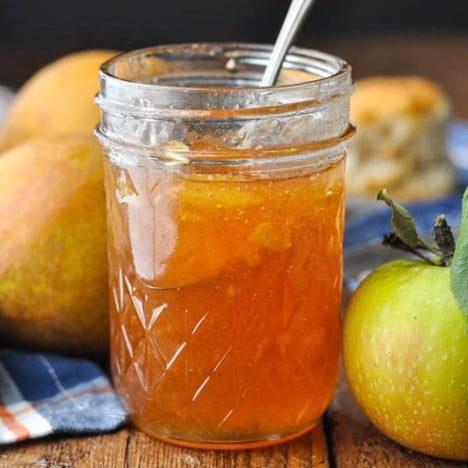
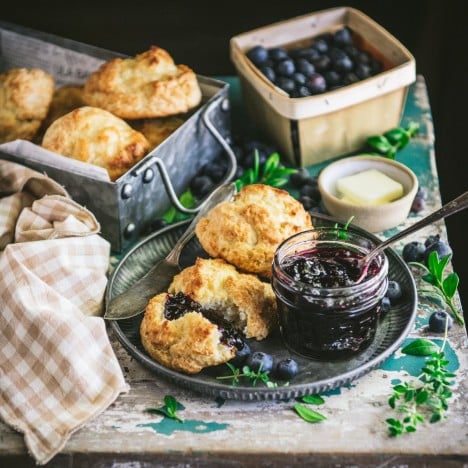
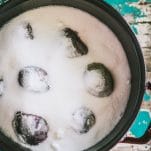
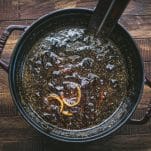
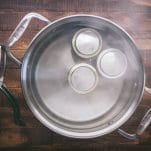

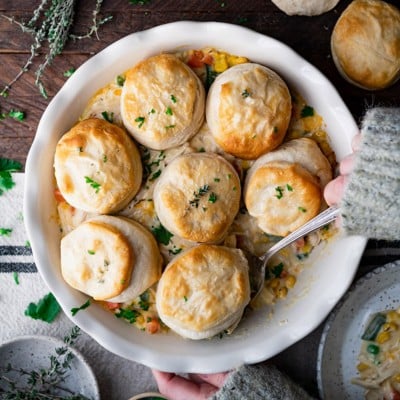
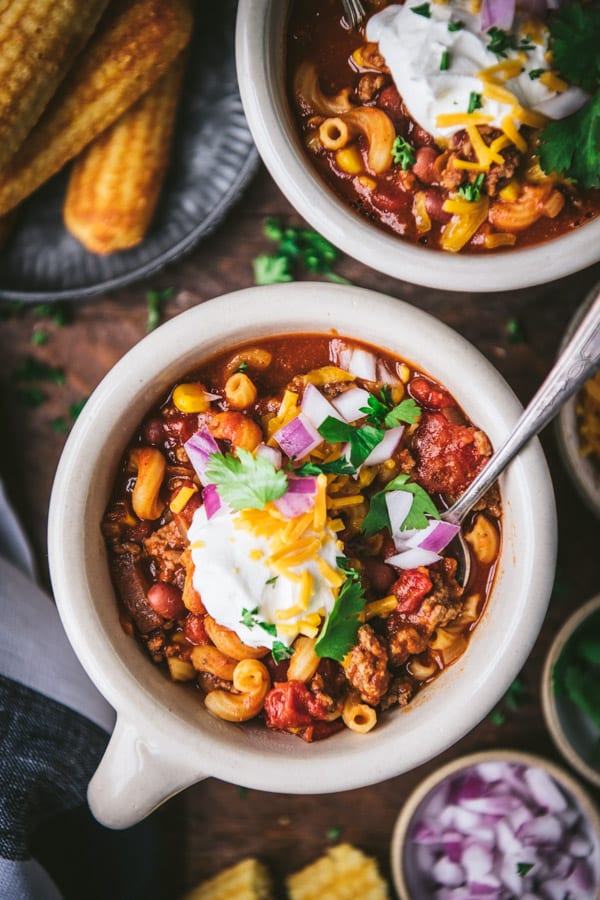
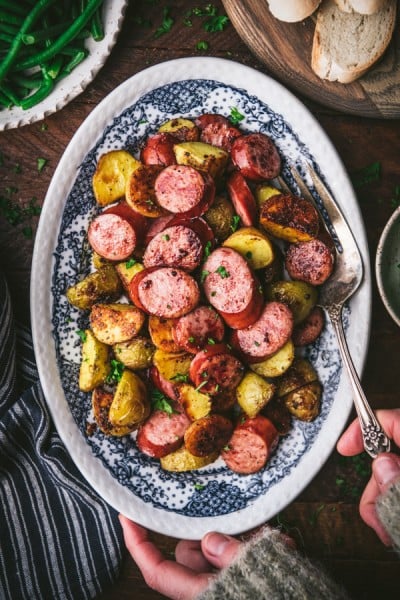








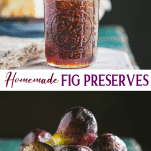
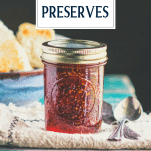
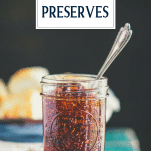
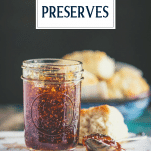
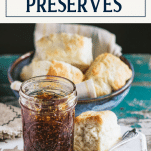
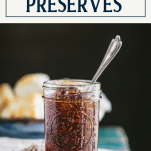
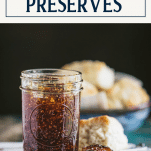
I have been making fig jam for 2 weeks. I have 2 trees that set early fruit and have access to 3 other trees as well. Two days ago I picked 30 pounds of huge figs from one tree. It was amazing. Still there are more figs to ripen. I always use the long cook method for my fig jam. No added pectin..
Oh my goodness, Leia! You’re in fig heaven! 🙂
I opened a jar of figs, there was mold around the top! They are four months old! Can I still eat them if I remove mold?
Hi, Denny! I wouldn’t. Jam turns moldy when mold spores come into contact with moisture inside the jam jar. This can happen if the jars were not properly sterilized before the jam was poured and sealed, so it’s not a risk that I like to take. 🙂
Do I leave figs and sugar overnight in refrigerator or at room temp? My figs were already refrigerated before adding sugar.
Leave them at room temp. 🙂
Help!!!!! I put my figs in a large pot after stemming them and covered with sugar. No juices came out. What do I do now?
Hi, Ginny! If the figs are nice and ripe, and if they’ve had time to sit in the sugar overnight, they should be fine. I would proceed with cooking them down and assume that they will release liquid as they cook. 🙂
I make a spiced fig jam, using Sure Jell, every year except last summer I did not get around to it. A friend gave me some figs that she had put in the blender and then frozen. She said it was the right amount ( she also uses my recipe). This spring, I made a batch using the frozen puréed figs. It did not jell. It was totally liquid. And it was a lot of jars!!
But onto this year…. I am at the beach house…. Where many fig trees are here on the island…and my food scale is in VA. Using SureJell recipe, I just measure out puréed figs into a certain amount of cups.
To make your recipe… how do I know how many cups are 1 and 1/2 pounds of whole figs? I just Googled it and depending on what site… they were different…. Anywhere from 3 and 1/4 cups to 4 and 1/2 cups…. I can’t rely on that …. To large of a discrepancy when you need the exact 50-50 proportion.
Any ideas?
Hi, Debbie! That’s right — using cup measurements isn’t really accurate enough for fruit jams when there’s such a discrepancy in the size of the fruit. I used really large figs, so the volume would have been way different than if I used smaller figs. My best suggestion is to use a kitchen scale to weigh the fruit. There’s really no other safe way to make sure that you have the proportions correct. A good kitchen scale is also a valuable tool for baking, so it gets a TON of use in my kitchen. 🙂
Something I have learned over the 40 years I have been canning….dead ripe fruit has less pectin than almost ripe fruit. I always use some figs that are less ripe to mix in with the ripe fruit I have picked.
That’s a great tip, Leia!
Hi,
Just refreshing my memory, for some reason my tree didn’t bear last year so it’s been awhile. But…I just noticed ripe figs on my tree so I’ll be putting some up over the next week. And grazing on them for breakfast! . Thanks for the article, it’s exactly what my aging brain needed.
Sounds perfect, Blake. I’m glad that you’ll have plenty of figs to enjoy soon!
How many jars (8 oz.) OUT of 6 lbs fig
Hi, Peggy! The recipe states that 1 1/2 lbs. yields about 3 8-ounce jars, so 6 lbs. should yield about 12 8-ounce jars. Hope you enjoy!
Going to put up fig preserves tomorrow. I hope they turn out. They are small. I don’t have a tree myself a neighbor let me pick from their tree.
I bet they’ll be delicious, Virginia! Hope you enjoy. 🙂
Never made Fig Preserves until 2 days ago! Followed recipe to the letter! Why are my preserves too thin…..runny! I used the recipe that did not call for pectin! Not like I thought they should be! Now, will I have to throw this away? They are too thin to use , is there anything I can do to save 8 pints, that is a big loss! Please someone HELP! Email me, please! pmonda0624@gmail.com
Hi Pat!
It sounds like you just didn’t cook it quite long enough for the preserves to reach the jelling point. You don’t have to throw it away, though! It will still taste great. Try using it as a sauce on ice cream, yogurt, fruit, oatmeal, etc. Hope this helps!
My neighbor has a fig tree and gave me some figs. I decided to make fig preserves so i googled fig preserves and your Fig Preserve Recipe came up. The first time I made it with 4 cups of figs, 4 cups of sugar, and no lemon.
My husband LOVED it, but I wanted to try it with less sugar and lemon. So I made some more yesterday with 4 cups of figs, 3 cups of sugar and 1/2 lemon thinly sliced. It is delicious.
So glad I found your recipe! Thank you.
Robin
Thank you, Robin! I’m glad to know that it works with less sugar, too. So happy that you enjoyed it!
Blair good afternoon from GA! I just made a 14 pound batch of fig jam using this recipe and it came out fantastic. I reduced the amount of sugar to 9 pounds and used 6 lemons and this jam is just beautiful. I ended up with exactly 27 jars which is what I planned for using your figures. The jam is a beautiful amber color, rustic texture and a sweet, but not overly sweet taste. I swear I can hear homemade lard biscuits and charcuterie boards across the world screaming for just a little bit of this jam! Keep up the great work. BTW…from one professional to another, “career can be over-rated”; you will never regret giving up an attorney job for the hardest job you will ever love (being a mom) and pursuing your passion for good food. Thanks and God bless.
Mark
Thank you, Mark! I’m so glad to hear that it came out well, and I really appreciate your kind note. 🙂
Newbie here and I have a tree loaded with figs. Last year the racoons got them all. This year we have a dog. Haha. Can you please explain the jelling point? Once I reduce the heat do I want it to be at 220 for 2 hours? Or cook for 2 hours until it’s about 220?
Hi, Trina! You will cook the jam for about 2 hours, until it thickens (it will continue to thicken more as it cools). You don’t even really need to worry about the temperature.
If you are taking the temp, it should eventually reach about 220 degrees after about 2 hours of cooking — and that’s when you can remove it from the heat.
Hope that helps, and enjoy the preserves!
I have the figs simmering on my stove now. This is my first time ever doing anything with figs. Silly question- Do I leave the lemon rind in when I put in my jar? Or do they break down while cooking?
Thank you!
Hi, Melissa! They soften and break down a good deal, so I always just leave them in there. If you prefer, you can certainly pull them out before canning. Hope you love it!
Important: All home-canned Figs must be acidified before canning in a boiling water canner to make them safe from the microorganism that causes botulism.
This is from the USDA. I remembered reading on their site that figs had to be acidified and it’s for the purpose of proper food preservation. I’m going to try this recipe. I’m a country girl who has not followed in my mom’s footsteps and participated in canning. Now my son has a fig tree loaded with fruit and I want to try.
Lemon is used to acidify. I didn’t make that clear!
Two hours was perfect! Just when my timer went off, my candy thermometer suddenly read 220 and figgy syrup looked like real preserves. Magic!
I forgot to buy a lemon. Would be 30 mile round trip to get one. Can I substitute a little fresh lemon juice that I have?
Hi, Thelma! I haven’t tested that, but I think it should work. I just don’t know an exact measurement to tell you. Maybe 1.5 tablespoons or so?
Do I wash my figs first
Hi Kathleen,
If your dogs haven’t been pre-washed, it’s a good idea to give them a quick rinse.
Since there’s no added pectin, can I double or even triple the recipe? Also, can you be more specific about the recipe’s yield, i.e., what does 3 servings mean– 3, 8 oz. jars, or??? Thanks!
Hi, Tess! Yes, you should be able to scale the recipe to double, triple, etc. the ingredients. The recipe yields three 8-ounce jars of preserves. Hope you enjoy!
I’ve never canned foods. With a generous amount of gifted figs, following your instructions should be a breeze. I’ll sterilize jars and lids but prefer to freeze than do hot bath. Just fill jars leaving head room and place in freezer when completely cooled? Thank you.
Yes! Please let us know how it goes. We’re here to help if you have any trouble!
FYI…First time ever making preserves, so I have two questions please:
1. When cooking for the 2 hours, is this supposed to be with lid on or off?
2. States to cook at low, but also mentioned as “simmer”. When I think of simmering, it is usually a little more heat than low to make it simmer. Can you clarify? I don’t want to mess up on my first batch ever.
Additional question when not using lemon and if leaving out to cool, is it lids on or off?
You’ll want to put the lids on the hot jars right away — even if you’re not using the lemon. Just remember that if you don’t use any lemon, you need to store the preserves in the refrigerator — they will not be shelf-stable. Hope you enjoy!
Hi, Tami! You’ll cook with the lid off so that the steam can escape. You’ll want to keep the heat on low. It will likely bubble and simmer, but every stovetop is different. The goal is just to get it to the jelling point of 220-225°F, so it may take longer or shorter, depending on the temperature of your pot. I wouldn’t crank it too hot, though, or it’s more likely to scorch on the bottom of the pot.
This is my second summer using this recipe and everyone loves the preserves! One batch this year did not get as thick as usual. After cooling for 24 hours, the syrup still seems a bit liquid. Can I still store them in the pantry as usual?
Hi Mary,
We’re so glad you enjoy this recipe! Sorry your batch didn’t thicken. It might’ve needed a little extra cooking time! As long as it is properly sealed, it should stay fresh.
It’s how my Momma did figs, so glad I found this recipe! Even though she’s not with me any longer, I can enjoy a taste of the old days and Momma’s fig preserves.
We hope they bring back fond memories!
Just made this and it was wonderful. I did reduce the sugar to two cups because my figs were very ripe and sweet. Thank you for sharing!
You’re welcome, Stacy! We’re glad you enjoyed it!
I made these last year and they turned out excellent. I used the preserves to baste ribs and chicken for barbecues.
One question: Can I cook these in a slow cooker? If so, how long and what temp?
Hi, Stephanie! I’m so glad that you enjoyed it. Using it as a baste for savory ribs and chicken sounds amazing!
I don’t know if they could be made in a slow cooker. It might work, but you would likely need to use the “high” setting in order for the preserves to reach the jelling point of 220-225°F. Let us know if you give it a shot!
The fig preserves recipe was simple. The description was clear and easy to follow the instructions. I can’t wait to make it.
Thank you, Armond! Please let us know how it turns out!
I made the preserves and agree this is very easy. I did not have a thermometer but paid close attention stirring often. The texture turned out perfect. I have another bigger batch of figs so plan to make more today. Will use a little less sugar as these figs are very sweet.
We’re so glad it turned out well for you, Vicki!
Delicious recipe! Thank you. I’m not going through the canning process. Will these freeze well, and for how long? Thank you.
Thank you! Yes, to freeze unprocessed jars of preserves, be sure to leave about 1-inch of headspace at the top of each jar to allow for expansion. They will stay fresh for about 6 months.
Just finished a small batch of fig preserves.
Directions are a bit unclear on the lemons.
Commentary indicates lemon is part of the finished product. Directions say to lay slices on top before the two hour cook time.
At what stage are the lemons incorporated into the preserves?
I pulled most of mine out before the jarring. My preserves turned out fine.
Hi, Butch! You add the lemon slices as indicated in Step 2, and then they just stay in the pot and cook for a couple of hours with the preserves. I don’t ever remove them — they go right into the jars with the figs and syrup. Sorry for any confusion, but I hope they turned out well for you!
Omg, this turned out so good!! A friend gave me a small bag of celeste figs, so I used your weight measurement instructions. I left mine whole & they’re like little jewels in a lemony syrup! Delicious!!!
We’re so glad you enjoyed it, Angie!
Hello, I have a bountiful batch of figs from our tree that need to be canned and I just love the simplicity of your recipe. I am familiar with the canning process but I do not have a scale to weigh out my figs. Can I measure using a 3 quart pot to somehow figure out proportions? By that I mean if I were to go to a farm stand and bought the figs in quart size containers would it be the same? I am not sure about figuring out the sugar and lemon proportions either. Any suggestions would be most appreciated.
ADDITIONAL COMMENT~
I just measured my figs and it appears I have 6 quarts. Do you think that 1 1/2 pounds of figs equals a quart? Of so, then I can do the math from there. As I mentioned, I do not have scale so I am trying to use a quart measurement, but I don’t know here to begin!
Thanks a million!
Rita
Hi, Rita! It’s so hard to know, and can really vary depending on the size/type of figs. This website suggests that an average of 2.5 lbs. yields 1 quart, so that’s probably a good estimate: https://nchfp.uga.edu/how/can_02/fig.html#:~:text=Quantity%3A%20An%20average%20of%2016,color%20depends%20on%20the%20variety.
Hope that helps!
OMGosh! This is a wonderful help! I’ll submit a review after I make the fig jam.
I will be purchasing a food scale so this doesn’t happen again! Thank you so much for your prompt reply.
Awesome, thanks Rita!
What a terrific, simple recipe! The fig preserves turned out perfectly. I had about 7.5 pounds of figs and ended up using the bathroom scale (and my husband!) as means of measuring. I was hesitant to use the lemon slices, but I am so glad did. Adding the paper thin lemon slices gives this jam a nice a subtle ‘zing’. I used my hand held immersion blender just a little to break up the whole figs. Overall a great recipe with clear instructions.
I most appreciate the prompt response to my previous questions. I am very happy I stumbled upon your website and so happy I subscribed. Looking forward to reading, learning and trying so many new recipes and techniques.
Thanks again!
Thank you so much, Rita! We truly appreciate your review and support and are so glad you enjoyed the recipe.
Thanks for a really nice and well described recipe!
Thank you, Sofia!
I have used this recipe several times with the results remaining the same, and far superior thann any store bought no matter the brand.
Wonderful! Thanks so much for letting me know, Armond. 🙂